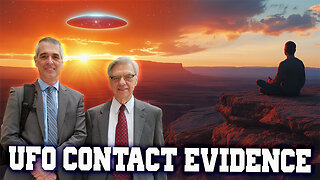Premium Only Content

Episode 2766: Advent Christology Course: Word Made Flesh: Session 2: The Mystery of the Incarnation
Session 2: The Mystery of the Incarnation
Theme: The Word Made Flesh
Duration: 1.5 hours
________________________________________
Welcome back to the Word Made Flesh series during advent. This is Session 2 The Mystery of the Incarnation and the first session was Longing for the Messiah
1. Introduction to the Angelus (2-3 Minutes)
Good afternoon, everyone, and welcome. To begin I want to wish you a joyful Feast day of the Immaculate Conception. It’s a joy to be gathered here together in faith and fellowship as we open this session dedicated to reflecting on one of the greatest mysteries of our Catholic faith: the Incarnation of our Lord Jesus Christ.
Today, we set aside this time to point to the profound truth that God chose to take on human flesh, to dwell among us, and to redeem us. The Incarnation is not just a theological concept; it is the cornerstone of our faith and the greatest demonstration of God’s love for humanity.
This session is an opportunity to pause and reflect deeply on this mystery the moment when the eternal Word became flesh in the womb of the Blessed Virgin Mary. Through her “yes,” Mary became the vessel through which salvation entered the world, and her Fiat teaches us the beauty of surrendering to God’s will.
So before we begin let me ask a question. What do Christ, the Blessed Mother and John the Baptist have in common but also of what they have in common how is it different?
As we begin, Let’s not only consider the theological depth of the Incarnation but also its personal implications that it has on our lives. How does the Word-made-flesh transform the way we live, pray, and respond to God’s call?
We will start by praying the Angelus, a timeless devotion that focuses on the Annunciation and invites us to contemplate the Incarnation. Together, we’ll reflect on Mary’s Fiat and allow this prayer to prepare our hearts to encounter God’s love more fully.
As I discussed this in detail at the beginning of Session 1 I will cover it as the starting point of each Session and that is the Angelus as a traditional Catholic prayer that has been prayed for centuries, honoring the moment the Word became flesh in the womb of the Blessed Virgin Mary. Emphasize its significance in deepening our understanding and appreciation of the Incarnation.
Share a brief historical note: The Angelus developed as a devotion in the 11th century and became a daily reminder of God’s presence, traditionally prayed at morning, noon, and evening.
The Angelus prayer evolved over centuries and does not have a single, definitive author. Its origins can be traced to medieval Christian devotion, with strong connections to monastic life and the tradition of praying at specific times of the day. Here's a brief history of its development:
Early Beginnings:
The Angelus is believed to have roots in the 11th century, when monks would recite three Hail Marys during the evening bell (Compline) as part of their Marian devotion. This practice likely spread to the laity over time.
Introduction of the Bell Call:
By the 13th century, the ringing of a bell, known as the "Angelus bell", became a widespread signal for praying three Hail Marys in honor of the Annunciation. Pope Gregory IX (reigned 1227–1241) is often associated with encouraging the practice.
I think the diocese of Chicago is one of the last diocese in the US that still rings the Angelus Bell.
Formalization of the Prayer:
The Angelus, as we know it today, took its more formal structure during the 14th century. Pope Urban IV (1261–1264) is said to have ordered the evening ringing of the Angelus bell. Later, in the 15th century, Pope Callixtus III (1455–1458) added the midday Angelus prayer to call for devotion during a time of crisis, specifically in defense against the Ottoman Empire.
Widespread Promotion:
By the 16th century, the Angelus was firmly established as a thrice-daily devotion morning, noon, and evening. It became more universal under the encouragement of Pope Sixtus IV (reigned 1471–1484) and other subsequent popes who recognized its spiritual significance.
Liturgical Development:
The specific texts used in the Angelus were likely developed organically from scriptural passages (especially Luke 1:28-38) and traditional Marian prayers, such as the Hail Mary. It emphasizes key elements of the Annunciation and Incarnation.
So, the Angelus is more the result of centuries of development within the Church's tradition rather than the work of a single author. It remains a powerful expression of devotion to the mystery of the Incarnation and Our Lady's role in salvation history.
• Highlight the central theme: Mary’s “yes” (her Fiat) and God’s active presence in human history.
________________________________________
2. Praying the Angelus (5-6 Minutes)
• Lead participants in praying the Angelus together, pausing after each section to reflect briefly on the significance of Mary’s “yes” to God’s plan and the mystery of the Word becoming flesh.
• Invite participants to bring to mind personal intentions as they focus on the mystery of the Incarnation.
• Invite everyone to participate, either by reciting aloud or reflecting silently. If printed copies of the prayer are available, distribute them, or display the text on a screen.
The Angelus Prayer:
1. Leader: The Angel of the Lord declared unto Mary,
All: And she conceived by the Holy Spirit.
(Pause for a moment of reflection): Reflect on the humility of Mary’s “yes” and how we can say “yes” to God’s will in our lives.
Leader: Hail Mary… (Participants pray the Hail Mary together)
2. Leader: Behold the handmaid of the Lord,
All: Be it done unto me according to Thy Word.
(Pause briefly): Contemplate Mary’s obedience and trust in God’s plan. Consider where we might deepen our trust in God today.
Leader: Hail Mary… (Participants pray the Hail Mary together)
3. Leader: And the Word was made flesh,
All: And dwelt among us.
(Pause briefly): Meditate on the mystery of the Incarnation. God took on human nature to dwell among us and redeem us. How does this truth inspire us to recognize God’s presence in our daily lives?
Leader: Hail Mary… (Participants pray the Hail Mary together)
Leader: Pray for us, O holy Mother of God,
All: That we may be made worthy of the promises of Christ.
Leader: Let us pray.
Pour forth, we beseech Thee, O Lord, Thy grace into our hearts, that we, to whom the Incarnation of Christ, Thy Son, was made known by the message of an angel, may by His Passion and Cross be brought to the glory of His Resurrection, through the same Christ Our Lord.
All: Amen.
________________________________________
3. Invitation to Personal Reflection (1-2 Minutes)
• After completing the Angelus, invite participants to bring personal intentions to mind, asking God for the grace to say “yes” in their lives as Mary did.
• Share a brief encouragement: Reflect on one way today you can live out the humility and obedience of Mary, trusting in God’s presence and His plan.
Invitation to Personal Intentions (2 Minutes)
I invite you now to bring to mind your personal intentions. Consider the areas in your life where God may be asking you to trust Him more fully, to step out in faith, or to surrender your own plans to embrace His. Perhaps you are seeking guidance, strength, or healing or perhaps you know someone who is in need of God’s grace right now. Hold these intentions in your heart and silently offer them to the Lord."
• Pause for silent reflection for 30 seconds.
• "As you do this, think about Mary’s 'yes' her Fiat: 'Be it done unto me according to Thy word.' Ask for the grace to echo that 'yes' in your own life, whatever God’s call may be."
Encouragement to Live Like Mary (2 Minutes)
As we reflect on Mary’s example, I encourage you to think about one way, just one, in which you can imitate her today. Maybe it’s by practicing humility in a difficult situation, or perhaps by trusting in God’s presence when the path forward feels uncertain. Mary teaches us to trust in the Lord’s timing and goodness, even when we cannot see the full picture. Her humility and obedience flowed from her deep confidence in God’s love and care. How can you bring this same trust into your life today?"
If you feel inspired, you might even jot down this thought to revisit later. Let it guide your actions and attitude as you go through your day.
Transition to the Next Segment (1 Minute)
As we move into the next part of our session, let us carry this spirit of reflection with us. The Angelus is not just a moment of prayer; it’s a preparation a way of grounding ourselves in the mystery of the Incarnation.
It draws us closer to Christ by reflecting on the Word made flesh and Mary’s role in this profound event. With hearts open and intentions placed before the Lord, we are ready to dive deeper into the beauty and significance of this mystery together.
Advent Wreath
Let’s not forget to light the second candle in our advent wreath.
Last week when we opened the session, the first week of Advent with the Prophecy Candle, which symbolizes hope. Longing for the Messiah. That candle, purple, reflects the hope and anticipation of the coming of the Messiah as foretold by the prophets of the Old Testament.
It invites Catholics to prepare their hearts and reflect on God's promises of salvation, encouraging a spirit of expectation and trust in the fulfillment of His plan.
This second week of Advent is represented by the “Bethlehem Candle”, which signifies faith and the journey of Mary and Joseph to Bethlehem. The candle is purple, symbolizing penance and preparation as Catholics anticipate the coming of Christ. It reminds the faithful of the prophecy of Christ's birthplace and calls them to deepen their trust in God's plan during this holy season.
In some traditions, this week may also focus on the theme of peace, reflecting the peace Christ brings to the world.
The Second Week Then the eldest child lights not only the first but a second purple candle. Both candles burn during the evening meal as before. If you, do it at after dinner and before bedtime then let the Candle burn for 15 minutes.
Father: “O Lord, stir up our hearts that we may prepare for Thy only begotten Son that through His coming we may be made worthy to serve Thee with pure minds through Christ our Lord. Amen.”
Advent Wreath Prayers 1 Our Father, 1 Hail Mary – Holy Mary and 1 Glory Be
2. Scripture Reflection (20 minutes)
John 1:1-14 and Philippians 2:6-11
The passages from John 1:1-14 and Philippians 2:6-11 together unveil the sublime mystery of the Incarnation, where divinity and humanity are united in the Person of Jesus Christ. This is the heart of our Catholic faith, the mystery that God so loved the world that He entered into His creation to redeem it.
John 1:1-14 – The Eternal Word Becomes Flesh
St. John begins with a declaration of Christ's eternal divinity:
"In the beginning was the Word, and the Word was with God, and the Word was God."
Now I covered John 1: 1-18 very extensively in the first session let’s tie in Philippians 2:6-11 “The Kenosis of Christ”
Who being in the form of God, thought it not robbery to be equal with God:
But emptied himself, taking the form of a servant, being made in the likeness of men, and in habit found as a man.
He humbled himself, becoming obedient unto death, even to the death of the cross.
For which cause God also hath exalted him, and hath given him a name which is above all names:
That in the name of Jesus every knee should bow, of those that are in heaven, on earth, and under the earth:
And that every tongue should confess that the Lord Jesus Christ is in the glory of God the Father.
This translation captures the profound humility and exaltation of Christ, aligning beautifully with traditional Catholic meditations on the Incarnation.
St. Paul describes Christ's Incarnation as an act of kenosis, or self-emptying:
"Though he was in the form of God, he did not regard equality with God as something to be grasped. Rather, he emptied himself, taking the form of a slave, coming in human likeness."
Here, the humility of God is laid bare. Christ, who holds all power and glory, veils His majesty and takes on the lowliness of our human nature. He submits Himself to the limitations of time, space, and suffering, culminating in the ultimate act of obedience: death on the Cross.
This passage also reveals the triumph of the Incarnation. Because of Christ’s humility and obedience, God exalts Him, and at His Name, every knee shall bow and every tongue confess that Jesus Christ is Lord. This reminds us of the cosmic scope of the Incarnation: Christ’s victory over sin and death glorifies God and brings salvation to all who believe.
Traditional Catholic Themes
God’s Infinite Love and Humility
The Incarnation is the greatest expression of divine love and humility. God did not abandon us in our sin but entered into the fullness of our human condition to save us. This calls us to awe, gratitude, and imitation of Christ’s humility.
Union of Divinity and Humanity
The Church Fathers, like St. Athanasius, taught that “God became man so that man might become God.” In the Incarnation, Christ unites humanity to divinity, restoring the dignity lost in the Fall. The Traditional Latin Mass reflects this mystery in its solemnity and reverence, drawing us to contemplate the divine condescension.
The Cross and the Incarnation
The Incarnation is inseparably linked to the Passion. Christ became flesh not only to dwell among us but to redeem us through His suffering and death. Every Nativity scene points to the Cross, reminding us of the cost of our salvation.
Eucharistic Connection
In the Incarnation, God becomes present in human form; in the Eucharist, He becomes present under the form of bread and wine. The humility of the Incarnation continues in the sacramental life of the Church, calling us to adore Christ truly present among us.
Conclusion and Reflection
St. Paul reminds us to imitate Christ’s humility, and St. John reveals the glory of God dwelling among us.
These two scripture readings when joined together weaves the rich theology of the Incarnation with traditional Catholic teachings, inspiring both awe and devotion among participants.
3. The Doctrine of the Incarnation: Jesus as True God and True Man
1. The Hypostatic Union
This union means Christ’s divine nature is not diminished by His humanity, nor is His human nature overridden by His divinity.
At the Council of Chalcedon (451 AD), the Church declared that Christ is “one and the same Son... perfect in divinity and perfect in humanity, truly God and truly man.”
So let me ask a question. Why was the Council called? I thought the 1st council of Nicea where we get our nicene creed took care of all that.
The Council of Chalcedon (451 AD) was called primarily to address the growing theological confusion and division over the nature of Christ specifically, how the divine and human natures of Jesus Christ were united in one Person.
This issue had been a subject of intense debate for centuries, and Chalcedon sought to definitively clarify the Church's teaching on the Hypostatic Union (the union of Christ's divine and human natures in one Person).
Here’s why the council was necessary:
While the First Council of Nicaea (325 AD) was crucial in affirming the full divinity of Jesus Christ and addressing the Arian heresy, it did not resolve all the theological issues surrounding the nature of Christ. Nicaea focused primarily on defending Christ’s divinity, specifically affirming that He is "consubstantial" (homoousios) with the Father, rejecting the teachings of Arius, who claimed Christ was a created being and not truly divine.
However, Nicaea did not directly address the relationship between Christ’s divine and human natures or fully clarify the mystery of the Incarnation the union of God and man in one Person. This is where the Council of Chalcedon (451 AD) came in.
Key Reasons for Chalcedon:
Theological Confusion After Nicaea: Despite the clarity provided by the Nicene Creed on the divinity of Christ, theological debates continued over the nature of Christ’s humanity and the union of His divine and human natures. The key issue was how the two natures coexisted in one Person.
Nestorianism: In the early 5th century, Nestorius, the Patriarch of Constantinople, proposed that Christ had two separate persons one divine and one human—joined together. He argued that the divine Logos and the human Jesus were distinct, leading to confusion about Christ's true nature and person.
Monophysitism: In contrast, Eutyches, a prominent monk in Constantinople, taught that Christ had only one nature, which was a combination of divine and human (often described as a "third nature"). He rejected the idea that Christ retained both His full divinity and full humanity, leading to the belief that Christ’s human nature was swallowed up by His divine nature.
Addressing the Heresies of Nestorianism and Monophysitism: The Council of Chalcedon was convened specifically to address these issues and correct the misunderstandings. Chalcedon issued the Chalcedonian Definition, which clarified the Hypostatic Union—the union of Christ’s divine and human natures in one Person.
The Council declared that Christ is one Person (not two) and that He exists in two complete and distinct natures: divine and human. These two natures are united "without confusion, without change, without division, and without separation."
Clarifying the Mystery of the Incarnation: The goal of the Council of Chalcedon was to safeguard the mystery of the Incarnation the union of God and man in Christ by defining the relationship between the divine and human natures in a way that would be free from both Nestorian (two persons) and Monophysite (one nature) errors. The Council’s definition upheld that:
Christ is fully God and fully man.
His divine and human natures are united in one Divine Person.
These two natures are distinct, but they are not separated or confused.
Preserving the Fullness of the Gospel: By clarifying that Christ is truly divine and truly human, Chalcedon preserved the integrity of the Gospel message. If Christ were not fully divine, He could not save us; if He were not fully human, He could not truly represent us and redeem our fallen nature. Chalcedon, therefore, ensured that Christ’s role as both God and Savior was properly understood.
In Summary:
The Council of Chalcedon was called because the First Council of Nicaea addressed only the divinity of Christ, but left unresolved questions about the union of Christ’s two natures (divine and human). Chalcedon clarified these issues, countering the heresies of Nestorianism and Monophysitism, and defining the orthodox belief in the Hypostatic Union—that Christ is one Person with two distinct, unconfused, and inseparable natures. This was necessary for preserving the truth of the Incarnation and for safeguarding the salvation of mankind through Christ’s full participation in both divine and human realities.
In short these were what they call Christological Heresies!
So let me ask you a question. What is the Importance of Defining the Hypostatic Union?
Only if Christ were truly divine could His death on the Cross be of infinite value to atone for the sins of mankind. But equally, only if He were truly human could He represent humanity and suffer on our behalf.
The Need for Unity
The theological confusion caused by these heresies had led to deep divisions within the Church. The Council of Chalcedon was crucial in unifying the Church around the truth of the Hypostatic Union, preserving the apostolic faith, and ensuring that the doctrine of Christ’s nature was consistent across the Christian world.
The Incarnation as Fulfillment of God’s Promises
o Use Genesis 3:15 (Protoevangelium) to trace the promise of salvation.
I was originally going to present this in session 1 but felt it was better in this session.
o Quote St. Athanasius: “The Son of God became man so that we might become God.”
The Incarnation as the Fulfillment of God’s Promises
The Incarnation the moment when the Son of God became man in the person of Jesus Christ stands as the central mystery of the Catholic faith. It is the moment in which God fulfills His promises of salvation to mankind. To understand the Incarnation as the fulfillment of God’s promises, we must look back to the earliest hints of God's redemptive plan, first presented in Genesis 3:15 and later developed throughout sacred history.
Genesis 3:15 – The Protoevangelium
In the aftermath of Adam and Eve’s fall, when they ate the forbidden fruit in the Garden of Eden, God issued a solemn promise of redemption. This moment is often referred to as the Protoevangelium, or "first gospel," because it is the first announcement of the coming of a Savior. In Genesis 3:15, God speaks to the serpent (Satan) and says:
“I will put enmities between thee and the woman, and thy seed and her seed; she shall crush thy head, and thou shalt lie in wait for her heel.” (Genesis 3:15, Douay-Rheims)
This verse, though it appears cryptic, is profound. It marks the first reference to the victory of a woman’s offspring over the forces of evil, the serpent (Satan). Several key elements emerge from this verse:
1. The Woman: The "woman" referred to here is Eve, but in the Christian tradition, this also points prophetically to Mary, the Mother of Jesus. The Church has long interpreted this passage as a foreshadowing of the Blessed Virgin Mary's role in the coming redemption.
2. Her Seed: The "seed" of the woman refers to Jesus Christ the Messiah who would be born of Mary. This promise foretells the coming of a Savior, a Redeemer who would undo the damage caused by Adam’s sin and restore humanity to God.
3. Victory Over the Serpent: The serpent represents Satan. The promise that the woman's seed would crush the serpent's head is a prophecy of Christ's ultimate victory over sin, death, and Satan. Christ, in His humanity, would suffer from the serpent's sting (the passion and crucifixion), but ultimately, He would crush the power of evil by His resurrection.
In this brief moment in Genesis, God sets in motion His eternal plan to send His Son into the world in the fullness of time, to bring about the salvation of mankind. The Incarnation is the fulfillment of this very promise: God Himself becomes man to defeat sin and death, just as He promised in Genesis 3:15.
St. Athanasius: "The Son of God became man so that we might become God"
One of the most profound theological insights regarding the Incarnation comes from St. Athanasius, a Church Father and champion of Nicene orthodoxy. In his famous work, "On the Incarnation", St. Athanasius offers a succinct yet deep reflection on the mystery of the Incarnation:
“The Son of God became man so that we might become God.” — St. Athanasius
This statement is a reflection of the doctrine of theosis (or divinization), which holds that through the Incarnation, Christ came to elevate humanity to participate in the divine life. This doctrine is deeply rooted in Scripture and the teachings of the early Church and offers an essential key to understanding why the Son of God assumed human nature.
So here is a question, what does St. Athanasius’ statement mean?
1. God's Desire to Elevate Humanity: The Incarnation is not merely about God rescuing us from sin; it is also about His desire to elevate us, to draw us into communion with Him in a way that goes beyond what was possible before. By becoming human, Christ restores the dignity of humanity, allowing us to be "partakers of the divine nature" (2 Peter 1:4). Through His union with humanity, we can now share in the very life of God.
2. The Ultimate Purpose of the Incarnation: Jesus, as the God-man, becomes the bridge between God and humanity. In His life, death, and resurrection, Christ opens the way for humanity to enter into God's presence. By taking on our nature, He sanctifies it and offers it back to the Father, allowing us to be transformed and united with God. In this way, we are called to become sons and daughters of God in the fullest sense, adopted into His divine family, as heirs of His eternal kingdom.
3. Restoration of the Image of God: Originally, humanity was created in God’s image and likeness (Genesis 1:26-27), but through sin, this image was marred. Christ, the New Adam, comes to restore the divine image within us, repairing the damage done by sin. Through His humanity, He shows us what it means to live as God intended—perfectly united with the Father, living in love and holiness.
4. The Role of the Eucharist: The Eucharist is the ultimate means by which we experience this divine union. Through the Eucharist, we receive Christ’s Body and Blood, which allows us to be united with Christ in the most intimate way. This sacrament is the means by which the divine nature that Christ shares with us through the Incarnation is transmitted to our souls.
The Humility of the Incarnation (20 minutes)
The Incarnation is not only a theological mystery but also a profound revelation of God’s humility. In taking on human nature, the Second Person of the Blessed Trinity, Jesus Christ, freely and voluntarily embraced a life of profound humility. This humility is encapsulated in the concept of kenosis, or self-emptying, as we find in Philippians 2:6-7. The Incarnation serves as a divine paradox: the infinite and all-powerful God chooses to become finite, dependent, and vulnerable for the sake of humanity’s salvation. This radical humility stands in stark contrast to the values upheld by the world today and offers a blueprint for Christian living.
1. Christ’s Self-Emptying (Kenosis)
The doctrine of kenosis comes from the Greek word κένωσις, meaning "emptying." It refers to the voluntary self-emptying of Christ’s divine prerogatives in order to take on human form and experience the fullness of human life, including suffering and death. Philippians 2:6-7 gives the clearest scriptural foundation for this concept:
“Who, being in the form of God, thought it not robbery to be equal with God: But emptied himself, taking the form of a servant, being made in the likeness of men.” (Philippians 2:6-7, Douay-Rheims)
This passage emphasizes two crucial aspects:
Christ’s Equality with God: Before His Incarnation, Christ existed in the form of God—eternally divine, sharing in the glory and majesty of the Father and the Holy Spirit. As the Second Person of the Holy Trinity, He possessed all the attributes of God: omniscience, omnipotence, and omnipresence.
Voluntary Self-Emptying: Despite this, Christ "emptied Himself"—not by losing His divinity, but by setting aside His divine privileges and prerogatives in order to assume a human nature. He chose to take the form of a servant, not as an appearance, but as a true human being, subject to the limitations of time, space, and human frailty. This was a willing act of humility, not a loss of His divine nature, but the embrace of humanity in its fullness.
In essence, the Incarnation is God’s supreme act of humility: He who is Almighty and beyond all comprehension chooses to become a helpless infant, born in poverty and vulnerability. Kenosis underscores that Christ did not take on human form as an abstract, detached entity but entered into the full reality of human existence, even to the point of suffering and death.
2. Countercultural Humility
The humility revealed in the Incarnation is profoundly countercultural, especially when contrasted with the values of the secular world. Today, we live in a culture that prizes self-sufficiency, pride, and the assertion of individual autonomy. The idea of humbling oneself—let alone emptying oneself for the sake of others—is often seen as weakness or folly.
Secular Culture and Dependence on God: Modern society tends to reject dependence on God. In a world that often glorifies human achievements, independence, and self-reliance, admitting our dependence on God is viewed by many as a weakness. The Incarnation, however, shows us the opposite: true strength lies in humility and dependence on God. The Son of God did not come to earth as a conqueror or a powerful ruler, but as a servant, reliant upon the Father and obedient even to the point of death (Philippians 2:8).
Challenges to the Virgin Birth and Supernatural: The doctrines of the Virgin Birth and the supernatural are often met with skepticism in modern culture. These doctrines, however, are not merely miraculous events to be scrutinized by human reason; they are signs of the limits of human pride. The world often looks to explain everything through naturalism, rejecting anything that cannot be perceived or understood by human reason. The Virgin Birth challenges the pride of human intellect, pointing to a reality that transcends human limitations. It also emphasizes that God, in His humility, entered the world in a way that defies human expectations—through a woman, in the most humble and hidden of ways. This humility affirms that God’s ways are not the ways of man (Isaiah 55:8-9), and His plan of salvation often operates beyond human comprehension.
3. Kenosis as a Model for Christian Living
In Philippians 2:5, St. Paul exhorts Christians to imitate Christ's humility:
“Let this mind be in you, which was also in Christ Jesus.” (Philippians 2:5, Douay-Rheims)
The humility of Christ is not just a theological fact; it is a model for Christian living. As members of the Body of Christ, Christians are called to live in the same spirit of self-emptying love and humility that Christ demonstrated. This is what it means to “have this mind among yourselves”—to adopt a mindset of humility that is willing to put others first, to serve, and to sacrifice.
Self-Emptying in Daily Life: Kenosis, as a model for Christian living, challenges us to empty ourselves of pride, selfish ambition, and self-centeredness. Christ’s humility calls us to put aside our own comforts, desires, and agendas in order to serve others, especially those in need. This is not a one-time act but a lifelong commitment to growing in humility and charity.
Humility in Relationships: In relationships—whether in marriage, family, or community—Christ’s humility should serve as the pattern. Humility means not insisting on our own way, but being willing to listen, forgive, and serve others. It involves being patient and kind, bearing the weaknesses of others, and extending mercy even when we feel wronged.
Humility in Suffering: Christ’s kenosis also serves as a model for Christians in times of suffering. Just as Christ embraced the cross out of love for humanity, Christians are called to embrace their own crosses, knowing that in suffering, they share in the humility and love of Christ. Christ's humility in suffering teaches us that our own suffering can have a redemptive value when united with His.
Discussion Questions
How does the concept of kenosis challenge our modern cultural values of self-reliance and pride? How can we incorporate this humility into our daily lives?
In what ways do the doctrines of the Virgin Birth and the supernatural reveal the limits of human pride and reason? How can we defend these truths in a skeptical world?
How can we imitate Christ’s humility in our relationships with others, especially when we are wronged or inconvenienced?
What does it mean to “have this mind among yourselves” (Philippians 2:5)? How can we grow in the virtue of humility in our Christian lives?
By reflecting on the profound humility of the Incarnation, we are called not just to admire Christ’s self-emptying, but to embody it in our own lives. As we seek to follow Christ, we are invited to empty ourselves of pride, to live in dependence on God, and to serve others in love, just as He has done for us.
The Incarnation as Fulfillment of God’s Promise of Salvation
The Incarnation is the fulfillment of God’s promises of salvation, which He began to reveal from the earliest moments of Scripture. From the Protoevangelium in Genesis, to the promise to Abraham and the Davidic covenant, and all the way through the prophecies of the coming Messiah, the Incarnation is the moment when God’s promises come to fruition in history.
• In Genesis 3:15, we see the first hint of God's plan to send a Savior who would redeem humanity.
• In Isaiah 9:6, we hear the prophecy: "For unto us a child is born, unto us a son is given; and the government shall be upon his shoulder: and his name shall be called Wonderful, Counsellor, The mighty God, The everlasting Father, The Prince of Peace."
• In Luke 1:31-33, the angel Gabriel tells Mary: "And behold, thou shalt conceive in thy womb, and bring forth a son, and shalt call his name Jesus. He shall be great, and shall be called the Son of the Highest: and the Lord God shall give unto him the throne of his father David: And he shall reign over the house of Jacob forever; and of his kingdom there shall be no end."
The Incarnation fulfills these promises, making salvation available to all who will accept it. Christ is the promised seed of the woman, the Son of David, and the Mighty God who has come to dwell among us, to save us from sin and death, and to restore us to the fullness of life with God.
In conclusion, the Incarnation is not only the fulfillment of the promises God made in the Old Testament but also the ultimate expression of His love. By becoming man, God allows us to become like Him. The Son of God became man so that we might become God—this is the core mystery and the greatest gift of our salvation. Through Christ's union of the divine and human natures, humanity is invited to share in the very life of God.
Closing Reflection and Discussion (10 Minutes)
Key Takeaways
1. The Hypostatic Union affirms Christ as True God and True Man, ensuring He is the perfect Redeemer.
2. The Incarnation fulfills God’s ancient promises and draws us into the divine life.
3. The Incarnation is essential for the sacraments, especially the Eucharist, where we encounter the Real Presence of Christ.
________________________________________
o Lead participants to consider how they can embrace humility in their own lives through practical service and detachment from pride.
Practical Application (10 minutes)
• Daily Angelus Devotion: Encourage participants to pray the Angelus three times a day as a way to honor the Incarnation and reflect on its mystery throughout the day.
• Humility Exercise: Challenge participants to identify one concrete way to practice humility and service in the coming week.
________________________________________Closing Prayer
Conclude by praying the Hail Mary together, invoking Mary’s intercession to grow in humility and understanding of the Incarnation.
Thank participants for their engagement and invite them to continue reflecting on the mystery of the Word made flesh.
________________________________________
-
 1:46:47
1:46:47
Game On!
1 day ago $14.49 earnedExpert Super Bowl LIX Picks, Preview, and Best Bets!
159K16 -
 36:50
36:50
Mrgunsngear
1 day ago $27.82 earnedPresident Trump's Executive Order To The ATF: This Could Be Huge!
127K76 -
 25:48
25:48
Adam Does Movies
1 day ago $4.02 earnedTop 10 Reasons Why Emilia Pérez Is Complete TRASH!
81.9K7 -
 26:56
26:56
MYLUNCHBREAK CHANNEL PAGE
1 day agoUnder The Necropolis - Pt 6
222K60 -
 6:03
6:03
Tactical Advisor
2 days agoEverything New From Panzer Arms 2025
49.8K2 -
 1:15:59
1:15:59
CarlCrusher
1 day agoUFOs & Paranormal Phenomena are Not Imaginary | Dr Jim Segala MUPAS Phase 2
51K3 -
 12:44
12:44
BlackDiamondGunsandGear
22 hours agoRadian Ramjet & Afterburner / Worth it? / Which Shoots Flatter?
61.7K4 -
 49:10
49:10
CharLee Simons Presents Do Not Talk
10 days agoDO NOT TALK with GIL MAZA & SAM ANTHONY (Mass Deportation Results)
40.1K -
 8:07
8:07
Tundra Tactical
1 day ago $4.92 earnedHiPoint Embraces The MEME Yet Again.
68K8 -
 36:00
36:00
hickok45
15 hours agoSunday Shoot-a-Round # 267
21.4K16